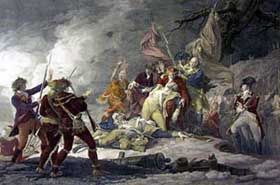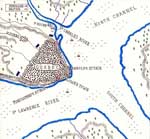Colonial Wars |
American Wars |
Link To This Page — Contact Us —
The Battle of Quebec
December 8-31, 1775 at Montreal, Quebec
 |
|||||||||||||||||||
|
It was early fall of 1775. General George Washington had taken command of the rag-tag, bobtail state's militia camped around Boston, and was endeavoring to turn the "rabble" into an army. He and the Continental Congress made the decision on June 27 to wrest Quebec and the St. Lawrence River from the British. They erroneously assumed that the tens of thousands of French-Canadians would gladly join the thirteen colonies in rebellion. Out of this momentous decision came one of the most amazing military expeditions of all time: Colonel Benedict Arnold's birch bark-canoe invasion of Canada, the first amphibious military assault in our nation's history. Arnold was to lead 1,100 soldiers from Massachusetts to Maine, then up the Kennebec and Dead Rivers into Canada by way of the Chaudiere River to Quebec City. Another army under Generals Phillip Schuyler and Richard Montgomery was to invade from New York, take Montreal, then meet Colonel Arnold at Quebec. This all came about, but ended in defeat for the Americans inasmuch as the British were well-positioned at Quebec, and Arnold's small army had been reduced by half by desertions. The French-Canadians did not rally to the American flag. Montgomery, replacing an ill Schuyler, was killed early in the attack; Arnold was wounded; and the campaign dissolved into disaster and retreat for the dejected remnants of the invading army.
On September 13, in Massachusetts, Col. Benedict Arnold set out for Canada in command of 1,000 volunteers including Capt. Daniel Morgan. Arnold planned to march up through Maine into Canada. The route turned out to be very difficult for the poorly supplied force with many portages to navigate, snowstorms and illness.
On October 16, Brig. Gen. Philip Schuyler returned to Fort Ticonderoga due to ill health, leaving Brig. Gen. Richard Montgomery in command.
On October 25, Col. Ethan Allen was captured during a failed attack on the British fort at St. Johns. Arnold lost 350 men who turned back, but the remaining 600 continued on. After a long siege on November 2, St. Johns fell to Montgomery.
On November 8, Arnold arrived at Point Levis on the St. Lawrence River, opposite of Quebec City.
On November 13, Montgomery occupied Montreal while Arnold was finally able to cross the St. Lawrence River. Arnold then withdrew to Point-Aux-Trembles and waited for reinforcements from Montgomery, while Carleton marched into Quebec City after having abandoned Montreal.
On December 3, Montgomery arrived at Point-Aux-Trembles with only 350 men, having left the rest at Montreal. On the 5th, Montgomery and Arnold began a siege and demanded surrender, which was rebuffed by Maj. Gen. Guy Carleton. Montgomery and Arnold knew they had to act soon, because the expedition's enlistments ended on the 31st. They decided to attack under the cover of a snowstorm. After a near miss on December 27, a huge storm brewed on the night of December 30.
On December 31,at 2:00 A.M. in the midst of a fierce snowstorm, muster was called in the Continental camp and a surprise attack on Quebec was soon underway. However, Carleton had been warned by an American deserter of the American plan. The Americans had intended to use the cover of a storm to move their men into position. Montgomery would take his 300 men and attack the city along the river from the west, while Arnold would take his 600 men, and attack from the east. The two forces would join in the middle of the business district in Lower Town and then march up the main route to Upper Town.

At 4:00 A.M., Montgomery fired rockets, signalling that he was in position and launching the assault. As Montgomery reached the western edge of Lower Town, he found a rough barricade had been thrown up by the British. The general, his aide-de-camp and a battalion commander walked forward to get a closer look at the situation. When the men were within yards of the barricade, the defenders of the barricade fired their lone load of shot from their cannon and fired their muskets. All 3 men were mortally wounded. The next in command, Lt. Col. Donald Campbell, immediately ordered a retreat. The panicked defenders continued firing even after the Continentals were long gone.
On the eastern edge of Lower Town, Arnold had launched his attack when he sighted the rockets. Having lost his 1 artillery piece on the way in a snowdrift, Arnold had no choice but to lead a frontal assault on another British barricade. Arnold was wounded when a musket ball tore into his leg. He attempted to continue on, but could not. He allowed himself to be carried from the from the fight, leaving Capt. Daniel Morgan in command. Morgan rallied the men and the Continentals overran the barricade after some heavy fighting. Morgan and his men raced through Lower Town, pouring over another unmanned barricade. Morgan was ready to continue toward Upper Town, but his subordinates advised caution and persuaded him to wait for Montgomery.
By dawn, Morgan finally grew impatient and ordered his men forward. The wait had cost the Americans their advantage and momentum. Carleton had used the time to position men throughout the city. As the Americans now attempted to move toward Upper Town, they were under constant fire coming from the surrounding houses. After fighting most of the day still hoping for aid from Montgomery, the Americans finally turned back. However, the once abandoned barricade was now occupied by Carleton's men and the Americans were trapped in the streets of the city. Fighting still dragged on as the American column spread throughout Lower Town. Eventually, almost the entire American force was captured or surrendered, as they were isolated in small pockets throughout the streets of the city. Morgan himself refused to surrender even when completely surrounded. He dared the British to shoot him, but his men pleaded with him until he finally turned his sword over to a French priest, rather than surrender it to the British.
Arnold was able to escape when Carleton recalled his men before they reached the hospital. He retreated to about a mile from Quebec City with the remaining 600 men and awaited reinforcements from Brig. Gen. David Wooster. He refused to retire from the field and continued his "siege" of Quebec. Word arrived that Montgomery had been promoted to major general on December 9.
On January 10, 1776, Arnold was promoted to brigadier general. In a few months, he was relieved of overall command by Gen. Wooster and was appointed commandant of Montreal. In May, the Americans began to withdraw from Canada as Maj. Gen. John Burgoyne arrived with over 4,000 troops.
On June 18, Arnold was the last American to withdraw from Canada. Thus ended America's actions in Canada for the remainder of the war.
With the British victory at Quebec and the later retreat of the Americans from Canada, another attempted annexation of Quebec was suggested in 1778 with the help of the French. But the plan was not implemented. Clément Gosselin and his spy network drafted a report on the state of Quebec in October 1778 for Congress which was planning another attack on the British in Quebec. In 1780 yet another attempt was considered, but George Washington, fearing he could not hold Quebec even if he took it, wrote Moses Hazen a letter explaining that he could not again risk being forced to leave Quebec and cause misery for the any Quebecois who were to support him.
